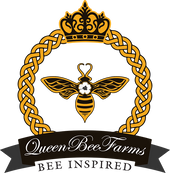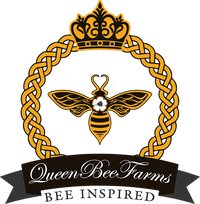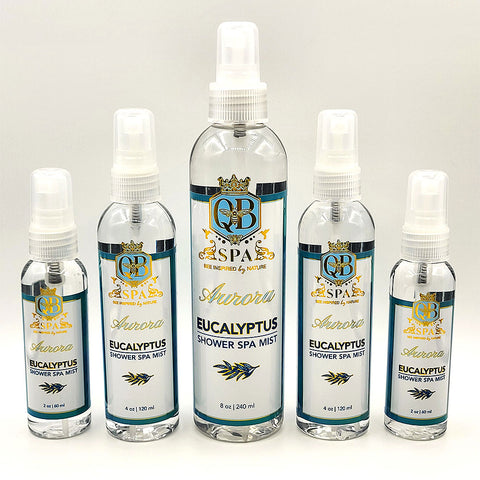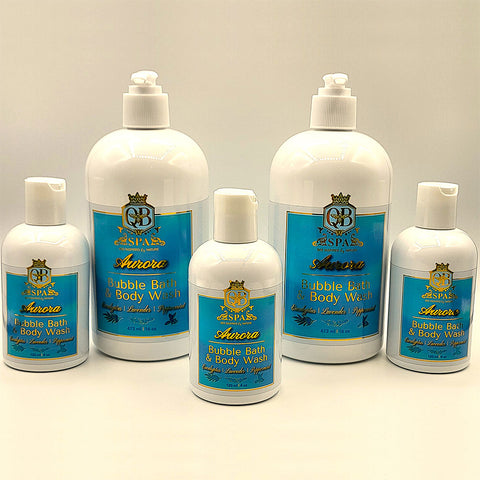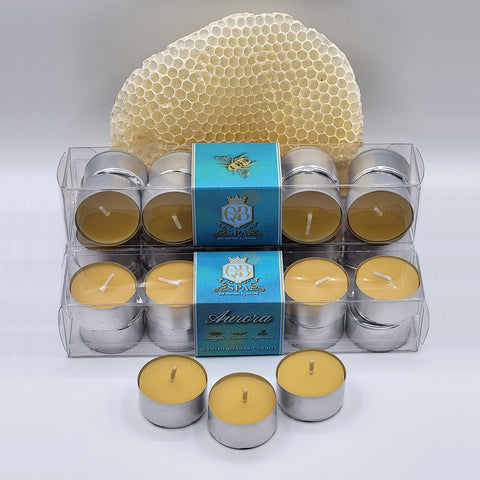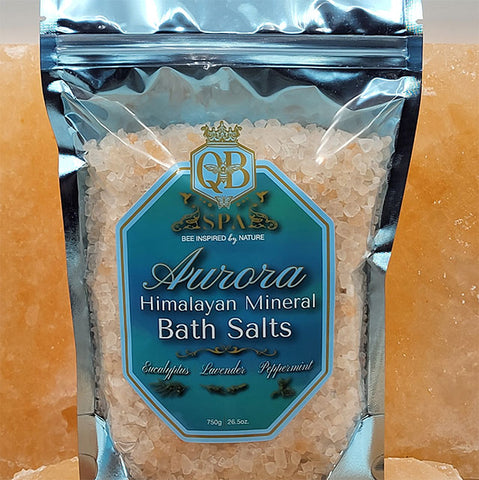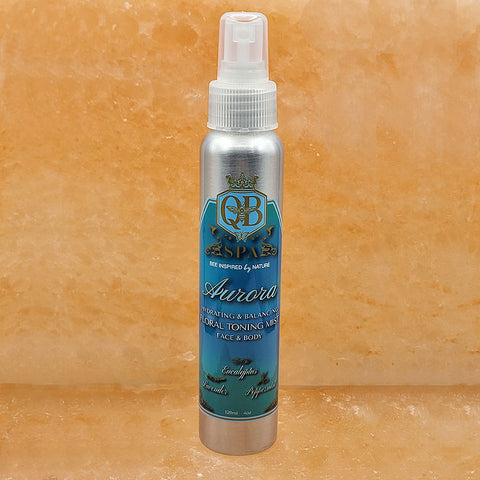Queen Bee Farms grows a wide variety of organically grown herbs, fruits and flowers, many of which are blended into Queen Bee Farms teas and other products. What we grow helps to support local and visiting pollinators by providing healthy food and habitat.
Herbs:
Scarlet Beebalm (Monarda didyma)

Scarlet beebalm is a beautiful perrenial herbaceous plant that is native to North America. The leaves have a scent that is similar to bergamot orange, and its red tubular flowers are a favourite of hummingbirds and bumblebees. Beebalm has antiseptic properties, and is commonly used for its calming and soothing effect. Beebalm is used in our Coastal Winter Mint Tea.
Borage (Borago officinalis)

Borage is an annual herbaceous plant that produces beautiful blue, star shaped flowers that are a favourite of honeybees and bumblebees. If allowed to set seed, borage self sows and pops-up around the garden year after year. The flowers, if picked and eaten fresh taste similar to cucumber. Borage is also a wonderful soil building and companion plant for tomatoes, strawberries, and squash to just name a few. Borage Oil has very high levels of GLA, which has incredible hydrating benefits for skin and sensitive skin issues. Borage is used in all of our Honey Herbal Soaps.
German Chamomile (Matricaria chamomilla)

German Chamomile is an annual herbaceous herb that has aromatic flowers that are commonly used in teas to treat insomnia and calm nerves. You will typically find this variety more often than its close cousin, Roman Chamomile, becuase German Chamomile blooms more prolificaly. It is commonly pollinated by butterflies and bumblebees, and attracts many other beneficial insects. German Chamomile is used in our Bumblebee Tea, and Rosemary & Mint Hydrating Floral Mist.
Roman Chamomile (Chamaemelum nobile)
Roman Chamomile is similar to German Chamomile in that it is in the same family of plants as well as having similar beneficial properties; however Roman Chamomile is a herbaceous perrenial that has larger flowers and prefers warmer climates to survive through the winter. It also attacts many pollinators and beneficial insects. The dried flowers are commonly used in teas to treat insomnia and calm nerves. Roman Chamomile is used in our Bumblebee Tea, and Rosemary & Mint Hydrating Floral Mist.
Coneflower (Echinecia spp.)

Echinecia is a perrenial herbaceous plant that is native to North America. It produces elegant purple, mauve, yellow, and some varieties of white coloured flowers that are a favourite of bumblebees, honeybees, and butterflies. Echinecia root and extracts have been shown to boost the immune system, increasing the bodies white blood cell count to fight infections.
Hops (Hamulus lupulus)

Hops are a perrenial vining plant that produce aromatic, cones or buds that when dried are commonly used for beer making. However, hops are also used in tea as an active ingredient to calm nerves and treat insomnia. Though mainly pollinated by wind, honeybees will sometimes collect pollen from hop cones.
Rosemary (Rosemarinus officinalus)

Rosemary known as the “dew of the sea” grows well along coastlines and in marine exposed gardens where it makes a good garden hedge. It is a woody perennial herb that produces fragrant resinous evergreen needle-like leaves. Depending on the variety, rosemary produces blue, white, or pink coloured flowers in the spring and fall which are a favourite nectar source for many bee species. Due to its aromatic properties the herb is used fresh or dried and is commonly added to culinary dishes and used in cosmetic products. We offer fresh cuttings of rosemary in season, and dried for our cullinary herb packs. Rosemary is also used in our Blue Moon Saskatoon Tea, Rosemary Lemon Myrtle Soap, Rosemary & Mint Hydrating Floral Mist, and Herbal Bath Tea.
Oregano (Oreganum vulgare)

Oregano is a bushy perennial herb known for its fragrant leaves that are used in many culinary dishes. A member of the mint family, oregano is widely grown across the Mediterranean, and sometimes referred to as wild marjoram. Not to confuse with the herb marjoram or sweet marjoram, oregano has a strong, spicy, and slightly bitter flavour; whereas the former has a more sweet mild and woodsy flavour profile. Oregano prefers sites with full sun and well drained, even rocky soils, making it a drought tolerant plant species. The white or pink flowers attract many different pollinators, and may self-seed spreading itself throughout the garden. We offer fresh cuttings of oregano in season, and dried for our cullinary herb packs.
Thyme (Thymus spp.)

Thyme is a low growing bushy herb that has both fragrant and decorative foliage commonly used in Mediterranean cuisine. It is a ‘bee-magnet’ when it is blooming in the early to mid-summer, producing many pink or white flowers. Thyme thrives on sites with full sun and well drained, even rocky soils, making it a drought tolerant plant species. We offer fresh cuttings of thyme in season, and dried for our cullinary herb packs. We use thyme in our Rosemary Lemon Myrtle Soap.
Sage (Salvia officinalus)
 Sage is a fragrant perennial evergreen shrub that typically grows soft grey-green or yellow variegated leaves. It prefers full sun but tolerates some shade, and once established sage can be drought tolerant. Most cultivars produce attractive blue, violet, or even red coloured flowers in the early to mid-summer season that are attractive to bees, butterflies, and hummingbirds. The leaves can be picked for fresh use, but are typically harvested and dried and used for culinary purposes. We offer fresh cuttings of sage in season, and dried for our cullinary herb packs.
Sage is a fragrant perennial evergreen shrub that typically grows soft grey-green or yellow variegated leaves. It prefers full sun but tolerates some shade, and once established sage can be drought tolerant. Most cultivars produce attractive blue, violet, or even red coloured flowers in the early to mid-summer season that are attractive to bees, butterflies, and hummingbirds. The leaves can be picked for fresh use, but are typically harvested and dried and used for culinary purposes. We offer fresh cuttings of sage in season, and dried for our cullinary herb packs.
Mint (Metha spp.)

Mint is a fragrant herbaceous perennial that vigorously spreads throughout the garden. It prefers moist rich soils, in full to partial sun exposures. If left unchecked in the right conditions, mint can take over a whole garden bed quickly. Its tender green leaves are commonly used to flavour sauces and drinks. Plus in late summer mints produce white or pinkish-white flowers that are commonly visited by bees and other pollinators. We grow a wide-variety of mints including Apple mint, Bergamot mint, Mojito Mint, Spearmint, and Peppermint. We offer fresh cuttings in season, and mint is found in our Coastal Winter Mint Tea, Monarch Tea, Mason Mint Tea, Dark Knight Tea, Rosemary Mint Hydrating Floral Mist, and Lime & Mint Honey Soap.
Anise Hyssop (Agastache foeniculum)

Anise Hyssop is a beautiful bushy perennial herb that is native to Western North America and is in the mint family. The plant prefers full sun to partial shade growing most vigorous in rich well-drained moist soils. It produces an abundance of fragrant purple flower spikes that are a favourite of bumblebees, butterflies, and hummingbirds. The leaves and flowers of Anise Hyssop emit a strong licorice scent when crushed and make a great tasting tea.
Lemon Balm (Melissa officinalis)

Lemon Balm is a bushy herbaceous perennial that is in the mint family. Although the little white flowers are small and inconspicuous, honey bees love them. When crushed the leaves have a strong lemony scent. The leaves are commonly used to flavour teas, and dried for sachets and potpourri. Its leaves are also edible and may be added to salads, soups, sauces or vegetables. Lemon balm has a long history of herbal medicinal usage for a variety of purposes including, calming anxiety, soothing insect bites, and treating colds. Lemon balm is used in our Monarch Tea and Hummingbird Tea.
Lavender (Lavendula spp.)

Lavender is an iconic woody perennial that has ultra fragrant violet, purple, blue, pink or white flowers that are a favourite nectar source of many different pollinators. It has calming and aromatherapeutic properties that make it a popular in soaps and cosmetics. Even add fresh lavender buds to culinary creations for a unique and complex flavour addition. Lavender thrives on sites with full sun and well drained, even rocky soils, making it a drought tolerant plant species. At QBF we grow English, French, and Spanish lavender varities. We offer fresh cuttings of lavender in season, and dried lavender buds in our cullinary herb packs. Lavender is used in our signature Lavender Lady Grey Tea, Victoria Fog Tea, Humminbird Tea, Monarch Tea, Bergamot Lavender & Honey Soap, Lavender Hydrating Floral Mist, and Herbal Bath Tea.
Fruits:
Apple (Malus spp.)

From wild begginings in apple tree forests in Central Asia, modern day Kazahkstan, the apple has grown into thousands of varieties worldwide, each one with unique chracteristics. A favourite of 'orchard' mason bees and honeybees, beautifully sweet smelling apple blossoms are pollinated in April and May to later form into the iconic fruit that we harvest and eat in the autumn months. At Queen Bee Farms we grow many varities of heritage and modern apple trees including Melrose, King, Chehalis, Gravenstein, Airlie's Red Flesh, Granny Smith, Ambrosia, and Jonagold. Apples from our orchard are dried and used in our Solstice Apple Chai Tea.
Cherry (Sweet Cherry - Prunus avium) (Sour Cherry – Prunus cerasus)

There is nothing better than eating a bowl full of fresh sweet cherries in the summer! Fruiting cherries are thought to have been grown since antiquity throughout North Africa, Central Asia and the Mediterranean. Now they are grown in most temperate latitude regions around the world. With hundreds of flowers blossoming on just one tree, fruiting cherry trees are a favourite of honeybees, bumblebees, and orchard bees. Queen Bee Farms grows Rainier, Lapins, and Stella varieties of Cherries. Dried cherries are in our Sakura Blossom Tea and Chocolate Cherry Chai Tea.
Red Raspberry (Rubus ideaus)

Rubus ideaus, commonly known as Red Raspberry, grows as a thicket-forming deciduous shrub with long arching canes if not pruned to height. They grow best in humus rich, well-drained soil in full sun, but will still bear a good amount of fruit to partial sunny conditions. It fruits biennially, meaning that raspberries will fruit on canes grown the year before. First year stems (primocanes) bear only leaves. Lateral branches in the second year (floricanes) produce leaves, flowers and fruits. Its flowers form in clusters that are usually white or rosy-pink in colour and are commonly visited by bumblebees and honeybees. Raspberry is used in our Raspberry Rose Honey Soap.
Blackberry (Rubus americanus)

Blackberries are a biennial thicket-forming deciduous shrub that thrives on disturbed sites, along roadsides, rivers, stream banks, fresh-water wetlands, riparian areas, forest edges, and wooded ravines. Although it is considered an invasive plant species, that does need management from taking over at-risk native ecosystems, it has naturalized as a pioneer species that provides shelter and food for many native animal species. On Southern Vancouver Island the blackberry blossoms in May provide a major nectar source for honeybees, as well as many solitary bees and bumblebee species.
Saskatoon ‘Service’ Berry (Amelanchier alnifolia)

Saskatoon berry is a multi-stemmed shrub or small tree that is a native plant found throughout Western North America. With a delicious sweet, nutty taste, the fruits resemble blueberries, and have long been eaten by Indigenous peoples fresh and dried. Saskatoons are widely adaptable to most soil types, grow in full sun or part shade, and are drought tolerant once established. It’s large white flowers blossom in the spring attracting many pollinators, and is an important host plant for many butterfly species. Saskatoon berries are in blended in our Blue Moon Saskatoon Tea.
Quince (Cydonia oblonga)

Quince is a deciduous multi-stemmed small tree or large shrub that grows crocked branches, and offers beautiful delicate rosy-pink flowers in the spring. In climates with warm winters, quinces will fully ripen on the tree/shrub and can be enjoyed fresh-picked with a heavenly citrus smell and pear-like flavour. However, in many areas where quince is grown in temperate regions, quince fruits are still very astringent in October when they first begin to ripen. Thus quince is usually cooked, turning to a beautiful pink-red colour in jellies, preserves, and pies rather than consumed fresh. Quince is blended in our Honeybee Tea.
Flowers:
Cornflower (Centaurea cyanus)

Cornflower is an annual flowering plant, that gets its name from historically being a common "weed" in cornfields. However, today blue cornflower is found in many gardens and used in many wild-flower pollinator attracting mixes. It produces a slightly sweet smelling and bright blue coloured flowers that attracts honeybees, bumblebees, and butterflies. Cornflowers are used in our Dark Knight Tea, Honeybee Tea, Craigdarroch Victorian Earl Grey Tea, and Blue Moon Saskatoon Tea.
French Marigold (Tagetes patula)

French Marigold is a compact annual plant in our area, but it can be a short lived perrenial in its warmer native growing range of Mexico and Central America. The aromatic and intense yellow, orange, red or bi-coloured flowers are a favourite of bumblebees and butterflies, and act as a natural deterant to many unwanted garden pests. Marigold also has natural anti-inflammatory and antioxidant properties, benefiting skin and oral health. Marigold flowers are used in our Bumblebee Tea, Mason Mint Tea, and Honeybee Tea.
Pot Marigold (Calendula officinalus)

Pot Marigold, aka Calendula, is a daisy like annual plant that typically has bright yellow or deep orange coloured flowers that are frequently visited by butterflies. In cooler growing climates, such as ours, calendula has a long blooming period from summer to early fall. Calendula flower petals are edible and may be added fresh or dried to soups, salads or rice dishes for both color and flavour. Calendula also has natural antiseptic and healing properties, benefiting skin and oral health. Calendula flowers are used in our Bumblebee Tea, Craigdarroch Victorian Earl Grey Tea, Lemon & Calendula Soap.
Rose - Petals & Hips (Rosa spp.)

Roses are a perrenial plant that come in many different colours, scents, growth habits (vining or bush), and single or double flowers. Our organically grown roses have beautiful fragrance and are commonly visited by mason bees, bumblebees, and butterflies. Did you know that Rose Hips are amazingly high in Vitamin C, even more than an orange by weight! Rose and rose petals are used in our Rose Queen Tea, Sakura Blossom Tea, Hummingbird Tea, Craigdarroch Victorian Earl Grey Tea, Rosewater Hydrating Floral Mist, and Raspberry Rose Honey Soap,and Herbal Bath Tea. Dried Rose hips are blended in our Mason Mint Tea, Woodland Skipper Tea, and Blue Moon Saskatoon Tea.
